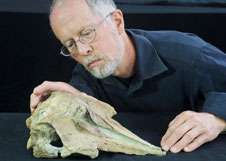Professor Ewan Fordyce examines the Papahu skull. Credit: RE Fordyce.
(Phys.org) —A newly recognised fossil dolphin from New Zealand, dubbed Papahu taitapu, is the first of its kind ever found and may be a close relation to the ancestors of modern dolphins and toothed whales, according to University of Otago researchers.
Papahu lived 19–22 million years ago, and is one of the few dolphins to be reported globally dating to the start of the Miocene epoch. Judging from the size of its skull, Papahu was about two metres long, roughly the size of a common dolphin.
Dr Gabriel Aguirre and Professor Ewan Fordyce, from the University's Department of Geology describe and interpret Papahu in the latest issue of Journal of Vertebrate Paleontology. This work was part of Dr Aguirre's PhD research.
Dr Aguirre says that like most living dolphins, Papahu had many simple conical teeth, but its head was probably a bit wider, and not as high-domed. It lived at a time of global warmth, in shallow seas around Zealandia – or proto-New Zealand – along with ancient penguins and baleen whales.
The skull, one jaw, and a few other parts of Papahu taitapu were found in marine sedimentary rocks in the Cape Farewell region of northern South Island. The researchers used the Māori name 'taitapu' to honour this region, and 'Papahu' is a Māori name for dolphin. Only a single specimen has been found so far and the fossil is housed in the University's Geology Museum.
"Our study of structures of the skull and earbone suggest that Papahu could make and use high frequency sound to navigate and detect prey in murky water. They probably also used sound to communicate with each other," says Dr Aguirre.
Features of the Papahu skull can be used to analyse relationships with other dolphins and toothed whales. That work shows that the skull is distinct from all previously-reported fossils, which is why the dolphin can be formally named as a new form, he says.
"When we compared Papahu with both modern and fossil dolphins we found that it belongs in a diverse and structurally variable group of ancient dolphins that evolved and spread world-wide 19–35 million years ago. All of those ancient dolphins including Papahu and others, such as shark-toothed dolphins, are now extinct," says Professor Fordyce.
"They have been replaced by the 'modern' dolphins and toothed whales, which diversified within the last 19 million years," he says.
It is not clear, however, exactly why Papahu and other ancient dolphins went extinct, he added.
More information: Aguirre-Fernández, G., and R. E. Fordyce. 2014. "Papahu taitapu, gen. et sp. nov., an early Miocene stem odontocete (Cetacea) from New Zealand." Journal of Vertebrate Paleontology 34:195-210.
Journal information: Journal of Vertebrate Paleontology
Provided by University of Otago























